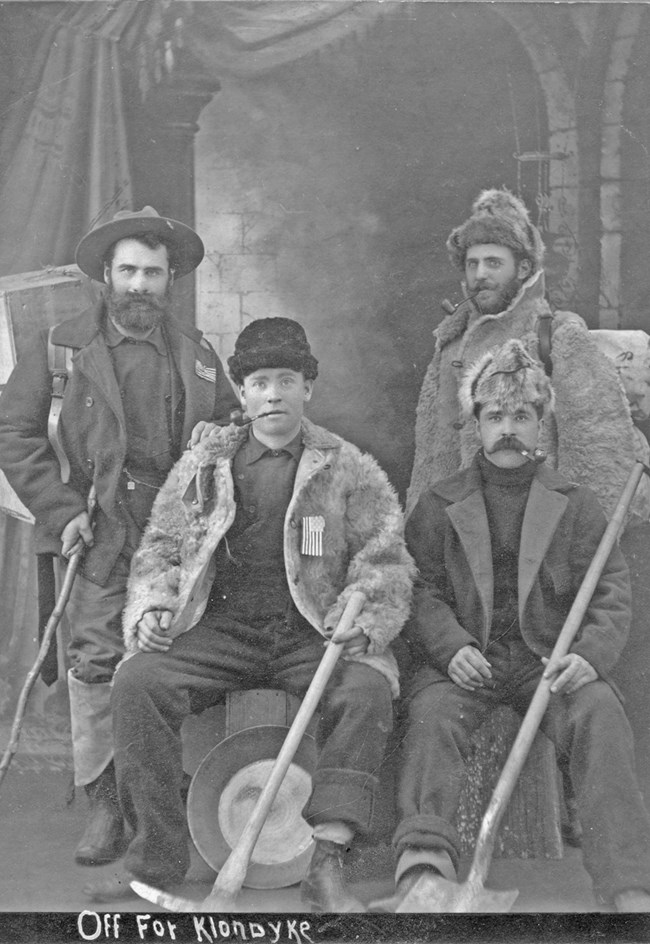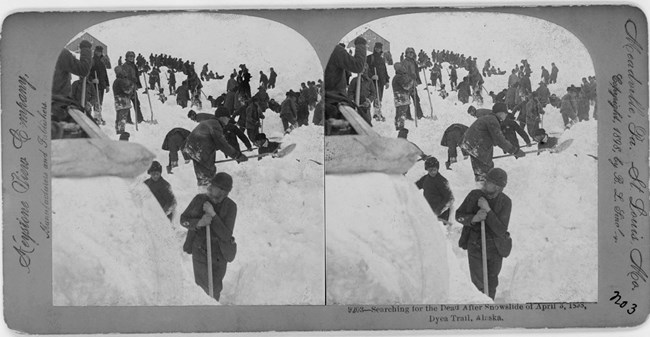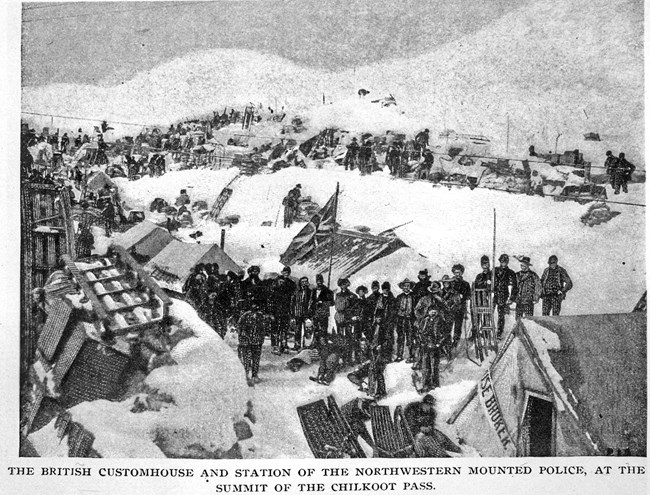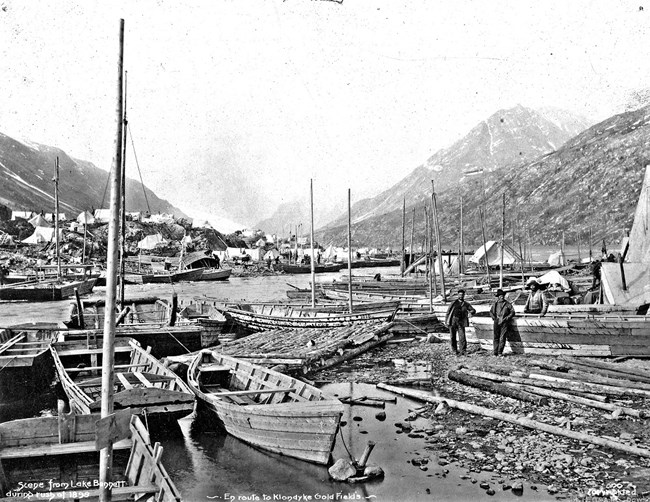Last updated: October 26, 2021
Article
Rushing to the Grave

National Park Service, Klondike Gold Rush National Historical Park, Palmer Collection, KLGO 50835.
Unprepared Stampeders
The Klondike Gold Rush was the international story of the year in 1897, so it is no surprise that tens of thousands of people went to seek their fortunes in the gold fields of Dawson City during the years of 1897 and 1898. Little did the fortune seekers know that the majority of stampeders would never make it to Dawson City, much less prospect for gold. Stampeders was the term used during the time of the Klondike Gold Rush to refer to the men and women who rushed towards the gold fields. Stampeders traveled from all over the world to the Klondike Gold Rush. Yet, few of them had the experience and necessary skillsets to survive in the North, much less the ability and know-how to prospect gold. By and large, the victims of gold fever were unprepared men. The majority of stampeders were men of Euro-American descent, and this article focues on their stories during the Klondike Gold Rush.
Common Causes of Death
One of the most common causes of death during the time of the Klondike Gold Rush was from contagious diseases. The White Pass and Chilkoot Trails were transportation corridors that led from Skagway and Dyea to the interior gold fields of Canada. These trails transported goods and people, as well transported diseases between stampeders. The 1898 outbreak of meningitis in Skagway is just one example of stampeders dying from contagious diseases during the time of the Klondike Gold Rush.
The second most common cause of death was trauma caused by physical violence. Most often trauma was inflicted during the commission of a crime. Skagway was a rough-and-tumble boomtown where a population of new inexperienced stampeders arrived with each steamer, and acts of violence were commonplace. Sam Steele of the Canadian North-West Mounted Police called Skagway, “...little better than a hell upon earth" and "...about the roughest place in the world." Up to sixty percent of people jailed in Skagway before 1903 were violent offenders, and twenty percent of the deaths during this period resulted from trauma related to violence. This number is most likely artificially low, as records from 1897 do not exist. Acts of violence also occurred on the White Pass Trail and Chilkoot Trail.
Typhoid fever was another major cause of death during the time of the Klondike Gold Rush. Many stampeders became sick with typhoid at the end of their journey while in Dawson City. After the stampeders paddled up the Yukon River, he or she would then travel to the gold fields of Dawson City, a boomtown largely built on a swamp with insufficient water and sanitation capabilities. Miners suffered from an outbreak of typhoid fever. Typhoid fever, a waterborne illness, is characterized by a high fever, diarrhea or constipation and a rash. The bacteria, transmitted in contaminated water and food would cause victims to become delirious and lose all energy, lying with eyes half-closed in a “typhoid state.” Along with typhoid, stampeders suffered from scurvy, a vitamin C deficiency resulting from a limited diet of bacon, bread and beans, the “three B’s.” One doctor in the Yukon Territory noted, “gold rushers tended to become indolent and careless, only eating those things which are most easily cooked or prepared. During the busy time…they work hard and for long hours, sparing little time for eating and much less for cooking.” Stampeders also became sick because of watered-down liquor. Liquor usually considered to be a safe bet in terms of infectious illness, was so watered down in Dawson City that the bacteria multiplied in bottles of spirits. One observer noted that by the end of the winter in 1898 “bars had been serving what amounted to whisky-flavored water.”

National Park Service, Klondike Gold Rush National Historical Park, Hooper Collection, KLGO 0004.005.004.0002.

Library of Congress
Palm Sunday Avalanche
Inclement weather and accidents were also major causes of death in the Klondike. The Palm Sunday Avalanche on April 3, 1898 is estimated to have killed sixty-five people on the Chilkoot Trail. Tlingit packers warned stampeders that springtime is known throughout the region as a dangerous time. Inexperienced stampeders did not heed the Alaskan Natives’ warnings and lost their lives as a result.

National Park Service, Klondike Gold Rush National Historical Park, George and Edna Rapuzzi Collection, KLGO 55803. Gift of the Rasmuson Foundation.
Preventing Death
Stampeders had to cross the pass in order to enter Canada. Stationed at the pass was a group of Canadian North West Mounted Police, also referred to as Mounties. In the Yukon Territory, the Canadian government took a more active role in managing the underprepared stampeders en route to Dawson City. The Mounties' regulation required each stampeder bring a year’s supply of goods, or about 2,000 pounds with them to Canada. While this may seem like an unreasonable requirement, we must remember that Dawson City had an unhospitable winter environment and limited supplies. In previous gold rush stampedes, a rush of underprepared fortune seekers to remote areas during the summer and fall seasons often meant starvation for the unprepared in the winter. The Mounties of 1898 learned from prior gold rush stampedes’ medical reports and documentation that a years’ supply of goods prevented death from starvation and exposure. Canadian Mounties also helped to prevent outbreaks of typhoid fever in Dawson City. During the spring of 1898, Mounties and community members improved Dawson City's water and sewer systems, and the typhoid outbreak was mitigated due to the improved waterworks.

National Park Service, Klondike Gold Rush National Historical Park, George and Edna Rapuzzi Collection, KLGO 55690. Gift of the Rasmuson Foundation.
When registering boats, the Mounties would inspect for river worthiness. The Mounties also had various checkpoints along the Yukon River, requiring stampeders to portage around rapids instead of continuing through them. Thus a journey, in which we would have expected quite a high death rate, had relatively few fatalities given the risk the river presented.
